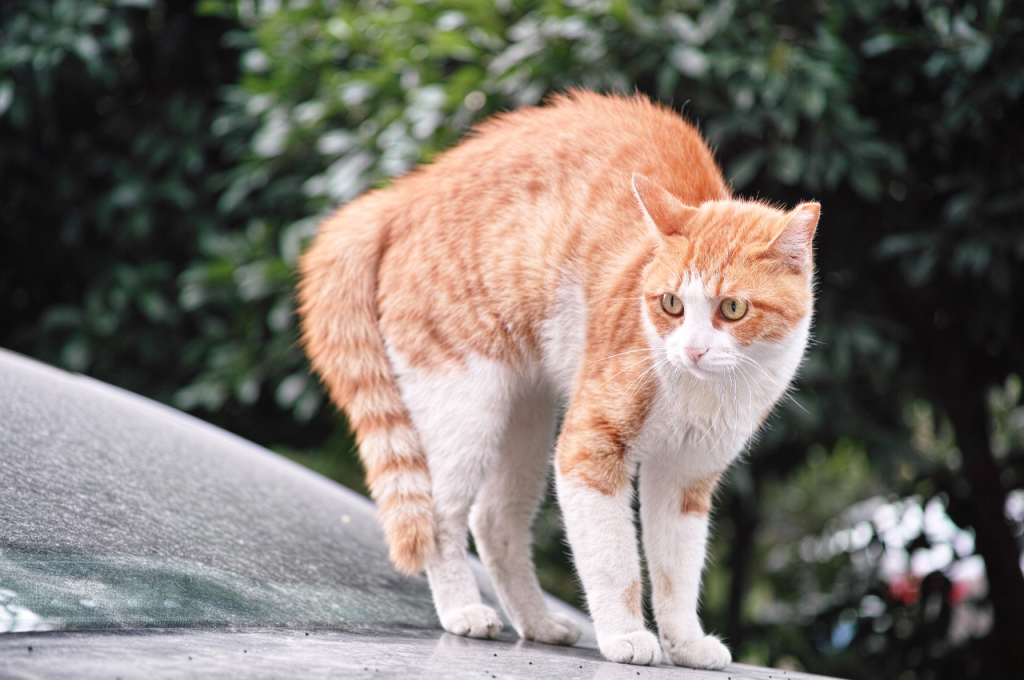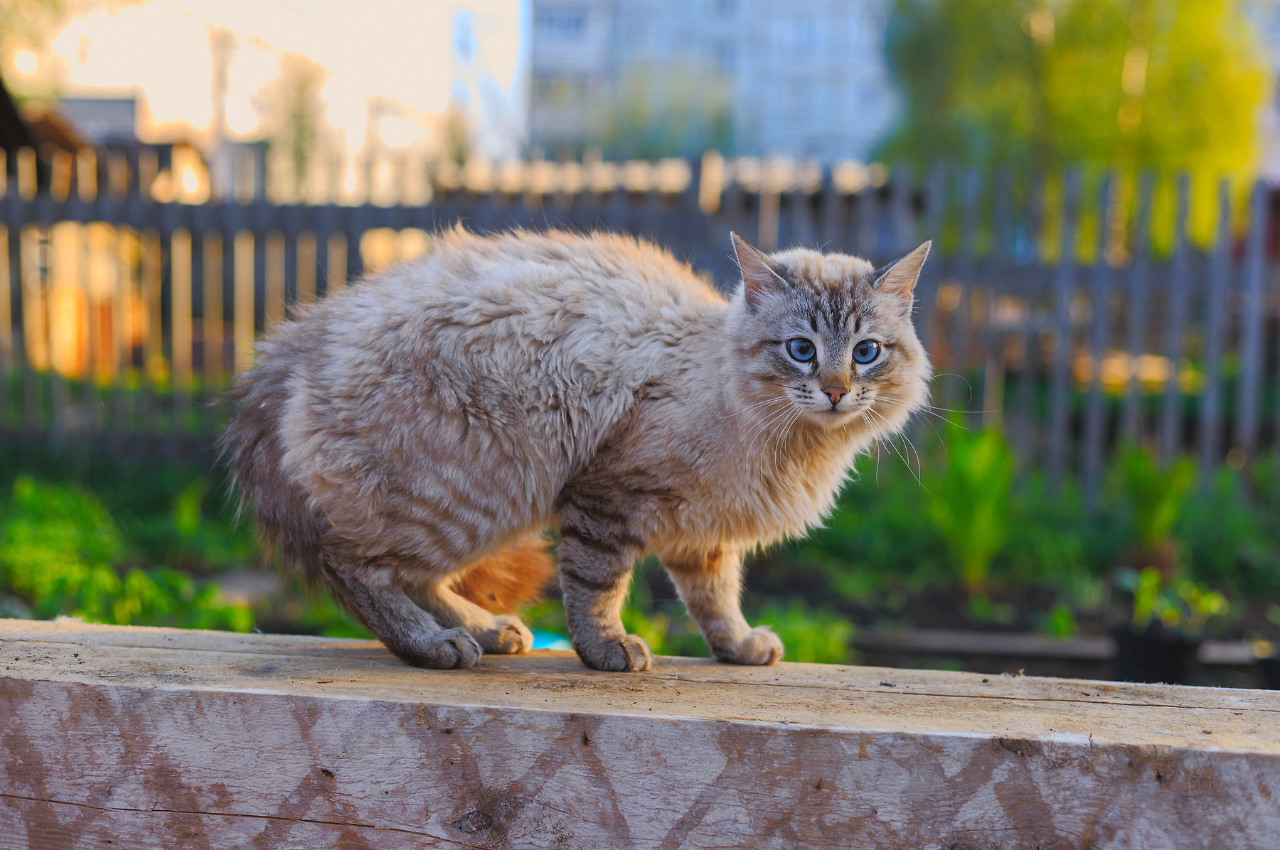When a cat is frightened, its body language can be seen in its flattened ears, dilated pupils arched back, and fluffed-up fur. Cats are known for their independent and fearless nature, but just like any other animal, they can feel scared or threatened.
It’s important to recognize the signs of a frightened cat, as it can help prevent potential harm to both the cat and the person trying to approach it. In addition to the physical cues mentioned above, a frightened cat may also hiss, growl, or try to hide. If you encounter a frightened cat, it’s best to give it space and avoid making sudden movements or loud noises. With patience and gentle behavior, the cat may eventually calm down and feel more comfortable.
The Silent Language Of Cats
A frightened cat’s body language speaks volumes through flattened ears, dilated pupils, and a low body stance. Understanding these silent cues is crucial for cat owners to provide comfort and reassurance to their anxious feline companions.

Cats are fascinating creatures, and it’s no secret that they have a language all their own. Unlike dogs, cats communicate using a variety of subtle body movements and vocalizations. Understanding cat body language is essential for any cat owner or lover. When it comes to frightened cats, there are specific signs to look out for, and in this post, we will explore the silent language of cats through the lens of frightened cat body language. Let’s start with the first indicator:
Tail Tales
A cat’s tail can tell you a lot about their mood and how they’re feeling. When a cat is frightened, their tail will likely be tucked tightly between their legs. This is a clear indication that they are scared and want to hide. On the other hand, if a cat’s tail is standing straight up, they are likely to feel confident and content. It’s important to pay attention to a cat’s tail when trying to understand their body language.
Whisker Wisdom
Another aspect of a cat’s body language that can help you determine if they are frightened is their whiskers. When a cat is scared, their whiskers will be pulled back against their face. This is a sign that they are trying to make themselves appear smaller and less threatening. Conversely, if a cat’s whiskers are forward-facing and relaxed, they are likely to feel calm and content. In conclusion, understanding cat body language is essential for any cat owner or lover. When it comes to frightened cats, there are specific signs to look out for, including tail tales and whisker wisdom. By paying attention to these subtle cues, you can better understand your cat’s mood and provide them with the care and comfort they need.
Ears Speak Volumes
When it comes to understanding a frightened cat’s body language, the ears are one of the most important indicators. Cats use their ears to communicate a wide range of emotions, from fear and anxiety to curiosity and contentment. By observing their ear movements, you can gain valuable insights into your cat’s state of mind and take appropriate actions to help them feel safe and secure.
Flattened Ears
One of the most evident signs of a frightened or threatened cat is flattened ears. When a cat feels scared or threatened, they will flatten their ears against their head, making them appear more streamlined. This defensive posture is an instinctual response aimed at protecting their vulnerable ears from potential harm. If you notice your cat’s ears pressed tightly against their head, it’s a clear indication that they are feeling frightened or anxious.
Rotating Ears
In addition to flattening their ears, cats may also rotate them to different angles when they are feeling fearful or uncertain. By rotating their ears, they are trying to pinpoint the source of the perceived threat or danger. You may observe your cat’s ears moving independently, swiveling in different directions as they try to gather information about their surroundings. This behavior demonstrates their heightened alertness and readiness to react if necessary.
It’s important to note that not all ear movements are indicative of fear or anxiety. Cats also use their ears to express their mood and intentions. For example, when a cat is relaxed and content, their ears will typically be in a natural, forward-facing position. However, when they are engaged in play or feeling curious, their ears may slightly tilt forward or perk up to show their interest in the environment.
Understanding a cat’s body language, especially their ear movements, is crucial for providing them with the care and support they need. By recognizing flattened or rotating ears as signs of fear, you can take steps to create a safe and calm environment for your feline friend. Providing them with a quiet space, avoiding sudden movements or loud noises, and giving them time to adjust can help alleviate their anxiety and restore their sense of security.
Fur Tells A Story
When it comes to understanding your cat’s emotions, their body language can speak volumes. One of the most telling signs is their fur, which can provide valuable insights into their state of mind. From puffed-up fur to shedding, a cat’s coat can reveal a lot about how they are feeling. Let’s take a closer look at how “Fur Tells a Story” when it comes to a frightened cat’s body language.

Puffed Up Fur
When a cat feels frightened or threatened, they may puff up their fur to appear larger and more intimidating. This defensive mechanism is a clear indication that your cat is feeling scared or anxious. It’s important to give them space and allow them to calm down in their own time.
Shedding
Frightened cats may also exhibit excessive shedding as a response to stress. If you notice your cat shedding more than usual, it could be a sign that they are feeling uneasy or fearful. Providing a quiet and safe environment can help alleviate their anxiety and reduce shedding.
Vocal Cues Of Distress
When cats are feeling distressed or frightened, they often use vocal cues to communicate their discomfort. Understanding these vocal cues can help cat owners provide the necessary support and care for their feline companions. Here, we’ll explore the vocal cues of distress, including hissing and growling, and how to interpret these signals.
Hissing
Hissing is a common vocal cue of distress in cats. When a cat feels threatened or scared, they may hiss as a warning to potential aggressors. This vocalization is often accompanied by an arched back, flattened ears, and dilated pupils. It’s essential to give the cat space and avoid further provocation when they are hissing.
Growling
Growling is another vocal cue that indicates distress or fear in cats. When a cat growls, it’s a sign that they are feeling threatened and may lash out if the situation escalates. It’s crucial to approach a growling cat with caution and to create a calm environment to help alleviate their distress.
Posture And Movement
The frightened cat’s body language reveals a hunched posture and cautious movements, indicating fear or discomfort. It may shrink back, arch its back, or crouch low to the ground, displaying an overall tense and defensive demeanor. Understanding these signals can help in providing a calming and reassuring environment for the cat.
Cats use body language to express fear and anxiety. Their posture and movement can provide clues to their emotional state.
Crouching
Cats may crouch close to the ground when frightened. They lower their bodies to appear smaller and less threatening.
Fleeing
When scared, cats may quickly run away to escape the perceived danger. Their movements are fast and erratic. In summary, a cat’s posture and movement can reveal a lot about its emotions, especially when it’s feeling frightened.
Creating A Safe Space
Creating a safe space for a frightened cat involves understanding their body language and responding appropriately. By recognizing signs of fear or anxiety, such as flattened ears or a tucked tail, and providing a calm environment, we can help them feel secure and build trust.

Creating a safe space for a frightened cat is crucial for their well-being. By understanding their body language and providing them with a secure environment, you can help them feel more at ease and less anxious.
Quiet Zones
Introducing quiet zones in your home can offer a sanctuary for a scared cat. Designate a peaceful area away from noise and foot traffic.
High Perches
High perches give cats a sense of security and control over their surroundings. Provide elevated spaces where they can observe without feeling threatened.
Frequently Asked Questions
Why Is My Cat Hiding All The Time?
Cats may hide when they feel frightened or stressed. It’s their way of seeking safety and security. Make sure to provide a quiet and comfortable space for your cat, with hiding spots like boxes or blankets. If the hiding behavior persists, it’s advisable to consult with a veterinarian to rule out any underlying health issues.
How Can I Tell If My Cat Is Scared?
Cats exhibit various body language signs when they are scared. Look for flattened ears, dilated pupils, a low body posture, and a tucked tail. They may also hiss, growl, or try to escape. It’s important to give your cat space and avoid forcing interactions when they are scared to prevent further stress or aggression.
What Should I Do If My Cat Is Frightened?
If your cat is frightened, it’s crucial to create a calm and secure environment. Avoid sudden movements or loud noises. Offer reassurance by speaking softly and providing treats or favorite toys. Gradual exposure to the source of fear, accompanied by positive reinforcement, can help your cat overcome their fears over time.
Patience and understanding are key.
Can I Train My Cat To Be Less Fearful?
Yes, you can help your cat become less fearful through desensitization and counterconditioning techniques. Gradually expose your cat to the things that frighten them, starting at a distance and rewarding them with treats or play when they remain calm. Over time, increase the exposure while continuing positive reinforcement.
Seek guidance from a professional animal behaviorist if needed.
Conclusion
Understanding your cat’s body language can help you build a strong bond. By recognizing signs of fear, you can provide comfort and security. Pay attention to tail movements, ear positions, and vocalizations to decode your cat’s emotions. With patience and observation, you can communicate effectively with your feline friend.
